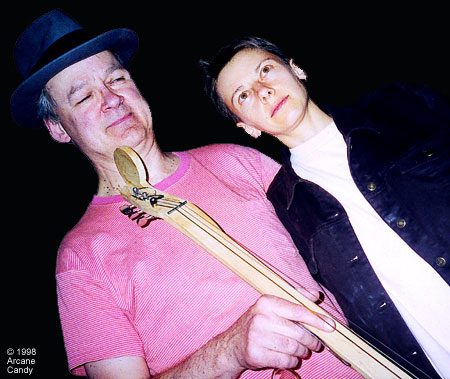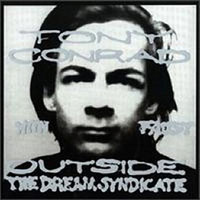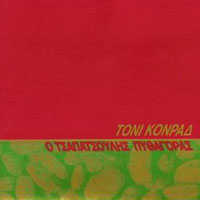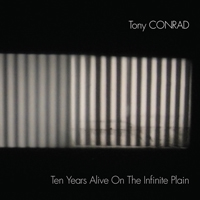A Glance at Tony Conrad

Tony Conrad and Alex Gelencser, 1998.
The early bird, I mean minimalist catches, I mean gets the worm, I mean word in edgewise–or actually a lot of words in every direction–all over the lengthy liner notes of the numerous LPs and CDs we will look at below.  Tony Conrad is one such large, flightless bird. From 1962 to 1965, he played violin in minimalist music founder La Monte Young’s Theatre of Eternal Music group, also known as the Dream Syndicate, which included La Monte and Marian Zazeela on drone vocals, John Cale on viola and Angus MacLise on percussion. Since La Monte’s been keeping the tapes “safe” in storage since the mid ’60s–for the most part denying access and copies to the other group members and the public at large–very few people outside of the original small audiences have ever heard what must have surely been the most searing, transporting drone music of all time. Practicing regularly, the group developed into the most awesome unit of 4:00 a.m. hover power. Perfect pitch, just intonation, long durations and massive amplification of the vocals, viola and percussion to tympanic membrane-cutting levels were some of the ingredients of this galaxy hub-bound stew.
Tony Conrad is one such large, flightless bird. From 1962 to 1965, he played violin in minimalist music founder La Monte Young’s Theatre of Eternal Music group, also known as the Dream Syndicate, which included La Monte and Marian Zazeela on drone vocals, John Cale on viola and Angus MacLise on percussion. Since La Monte’s been keeping the tapes “safe” in storage since the mid ’60s–for the most part denying access and copies to the other group members and the public at large–very few people outside of the original small audiences have ever heard what must have surely been the most searing, transporting drone music of all time. Practicing regularly, the group developed into the most awesome unit of 4:00 a.m. hover power. Perfect pitch, just intonation, long durations and massive amplification of the vocals, viola and percussion to tympanic membrane-cutting levels were some of the ingredients of this galaxy hub-bound stew.

Tony Conrad stepped outside the Dream Syndicate one time on December 19, 1964, when he recorded four overdubbed tracks of supremely grating violin screech drone of the highest kind–just the most visceral veils of undulating reality sparkle you could ever dream of floating through. Released as Four Violins by Table of the Elements in 1996 and a year later as a CD in the four-disc box set Early Minimalism, the 32 minutes of music is easily available and awaits your next long evening spent laying around at home, wrapped up in a fuzzy blankie while sipping hot cocoa. The Early Minimalism box set also includes three other CDs of recordings from 1994-96 made with Alexandria Gelencser on cello, Jim O’Rourke on violin and others that attempts to “reconstitute and re-project the lost dream music of the original Theatre of Eternal Music.”  Also enclosed is an enhanced CD with interviews and performance footage, plus a 96-page booklet of vintage archival photos and brain-hurting notes.
Also enclosed is an enhanced CD with interviews and performance footage, plus a 96-page booklet of vintage archival photos and brain-hurting notes.
After leaving the the Theatre of Eternal Music in 1965, Tony Conrad’s next recording wasn’t made until 1972, when he teamed up with krautrock group Faust for the Outside the Dream Syndicate LP on Caroline, which was reissued on CD in 1994 by Table of the Elements. Splaying his violin drone fabrics over the slow and precise metronome-like rhythmic foundation of Faust, Tony helped launch hundreds of late-night bedroom journeys in better-knowing homes across several continents. As if all that weren’t enough, Tony also recorded a new work in 1994–his first in 22 years–called Slapping Pythagoras, which is the thickest, warmest shawl of buzzing drone music you could ever desire to cuddle up and dream inside.  Containing two long, stunning slabs of beauty, it’s filled to the brim with layers of violin, guitar, bass, accordion, cello and bass clarinet all wailing away. It also features Jim O’Rourke working the weed trimmer and David Grubbs supplying an occasional low-end thud via pillow. Yes, pillow. What have you been up to? Slapping Pythagoras is the slowest rotating spiral arm in this or any other galaxy. It’s so good, I feel like slapping Conrad…on the shoulder.
Containing two long, stunning slabs of beauty, it’s filled to the brim with layers of violin, guitar, bass, accordion, cello and bass clarinet all wailing away. It also features Jim O’Rourke working the weed trimmer and David Grubbs supplying an occasional low-end thud via pillow. Yes, pillow. What have you been up to? Slapping Pythagoras is the slowest rotating spiral arm in this or any other galaxy. It’s so good, I feel like slapping Conrad…on the shoulder.
 Tony Conrad’s output of recordings continued unabated in the new millennium. Outside the Dream Syndicate got a 30th Anniversary expanded 2-CD treatment in 2002 with a 32-page booklet, a 93-page Table of the Elements catalog and a poster. The franchise was revived for a charming third time in 2005 with a live version (recorded at a reunion with Faust in 1995) called, appropriately enough, Outside the Dream Syndicate-Alive. In 2003, Tony Conrad laid down a challenge for fans of difficult music called Fantastic Glissando, a 1969 recording which boasts little more than a stereo-phase glissando produced by sine wave oscillator processed through a pump counter and a head gap delay. This is minimal music stripped down close to radio static levels.
Tony Conrad’s output of recordings continued unabated in the new millennium. Outside the Dream Syndicate got a 30th Anniversary expanded 2-CD treatment in 2002 with a 32-page booklet, a 93-page Table of the Elements catalog and a poster. The franchise was revived for a charming third time in 2005 with a live version (recorded at a reunion with Faust in 1995) called, appropriately enough, Outside the Dream Syndicate-Alive. In 2003, Tony Conrad laid down a challenge for fans of difficult music called Fantastic Glissando, a 1969 recording which boasts little more than a stereo-phase glissando produced by sine wave oscillator processed through a pump counter and a head gap delay. This is minimal music stripped down close to radio static levels.
 Released in 2005, Bryant Park Moratorium Rally features an anti-Vietnam War gathering in Bryant Park, Manhattan in 1969 recorded by Tony Conrad a block away through an open window in his loft. A weird delay effect is produced by a simulcast of the event from a TV in the same room. This CD should please fans of tweaked field recordings. In 2006, Tony went on to release an album with fellow early minimalist musician Charlemagne Palestine called An Aural Symbiotic Mystery. Although they hadn’t played together since the ’70s, this outing with Tony on violin and Charlemagne on keyboards reached a pinnacle of improvised splendor. The same year, 2006, witnessed the release of Joan of Arc, a gush of solo pump organ originally recorded back in 1968 as a soundtrack for the Piero Heliczer film of the same name.
Released in 2005, Bryant Park Moratorium Rally features an anti-Vietnam War gathering in Bryant Park, Manhattan in 1969 recorded by Tony Conrad a block away through an open window in his loft. A weird delay effect is produced by a simulcast of the event from a TV in the same room. This CD should please fans of tweaked field recordings. In 2006, Tony went on to release an album with fellow early minimalist musician Charlemagne Palestine called An Aural Symbiotic Mystery. Although they hadn’t played together since the ’70s, this outing with Tony on violin and Charlemagne on keyboards reached a pinnacle of improvised splendor. The same year, 2006, witnessed the release of Joan of Arc, a gush of solo pump organ originally recorded back in 1968 as a soundtrack for the Piero Heliczer film of the same name.
 From 2007 to his death in 2016, Tony went on to release a plethora of collaboration CDs on which he joined forces with such artists as Tim Barnes, Mattin, MV Carbon, Tovah Olson, Genesis Breyer P-Orridge, Jutta Koether, John Miller, C. Spencer Yeh, Michael F. Duch, and Edley Odowd. A documentary film on Tony’s life and work as a musician, artist, filmmaker and educator called Tony Conrad: Completely in the Present premiered in 2016–the same year he died. In 2017, Superior Viaduct posthumously issued a previously unreleased lo-fi recording of one of Tony’s subdued drones from 1972 called Ten Years Alive on the Infinite Plane, which was a perfectly timed funeral dirge. To sum it all up: Although Tony Conrad was one of the founding fathers of microtonal drones in the early 1960s, his music mostly languished in obscurity for three decades. A return to recording and live performance in the mid-’90s, however, lifted Tony to his rightful lofty position in the pantheon of the avant-garde, and his music went on to set an example for a whole new generation of dronesters.
From 2007 to his death in 2016, Tony went on to release a plethora of collaboration CDs on which he joined forces with such artists as Tim Barnes, Mattin, MV Carbon, Tovah Olson, Genesis Breyer P-Orridge, Jutta Koether, John Miller, C. Spencer Yeh, Michael F. Duch, and Edley Odowd. A documentary film on Tony’s life and work as a musician, artist, filmmaker and educator called Tony Conrad: Completely in the Present premiered in 2016–the same year he died. In 2017, Superior Viaduct posthumously issued a previously unreleased lo-fi recording of one of Tony’s subdued drones from 1972 called Ten Years Alive on the Infinite Plane, which was a perfectly timed funeral dirge. To sum it all up: Although Tony Conrad was one of the founding fathers of microtonal drones in the early 1960s, his music mostly languished in obscurity for three decades. A return to recording and live performance in the mid-’90s, however, lifted Tony to his rightful lofty position in the pantheon of the avant-garde, and his music went on to set an example for a whole new generation of dronesters.
More: Hyper Real, Wikipedia
Note: A shorter version of this article originally appeared in Arcane Candy Issue 1 in the year 2000.
Leave a Reply